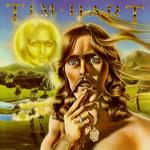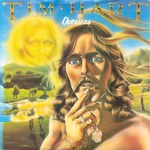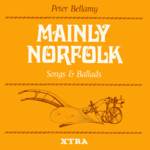> Tim Hart > Records > Tim Hart
Tim Hart: Tim Hart
 |
Tim Hart Chrysalis CHR 1218 (LP, UK, April 1979) Overseas / Hillman Avenger Chrysalis CHS 2335 (single, UK, p/s, May 1979) |
 |
Produced by Davy Rohl and Tim Hart;
Engineered by Davy Rohl;
Assistant Engineers Steve Broomhead and Chris Nagle;
Recorded at Strawberry Studios (North) Stockport;
Mixed at Strawberry Studios (South) Dorking;
Mastered by Melvin Abrahams at Strawberry Mastering London
Musicians
Tim Hart: vocals, acoustic and electric guitars, dulcimer, mandolin etc.;
Vic Emerson: synthesisers, keyboards;
Stewart Goldring, Ashley Mulford, Steve Broomhead: electric guitars;
Rick Kemp, Des Tongue, Pete Glennon: bass guitars;
Nigel Pegrum: drums, percussion;
Dave Hassel: percussion;
Alan Fawkes: flute, clarinet, saxophones;
Maddy Prior: vocals
Tracks
Side 1
- Keep on Travelling (4.57)
- Tuesday Afternoon (4.09)
- Hillman Avenger (3.06)
- Lovely Lady (3.03)
- Nothing to Hide (4.00)
Side 2
- Come to My Window (Roud 966) (6.32)
- Overseas (4.13)
- Time After Time (4.15)
- As I Go My Way (4.03)
All songs written by Tim Hart except
Track 6 trad. arr. Tim Hart
Sleeve Notes
This album features a solo project by one of the founders of Steeleye Span, Tim Hart, and was released in 1979 at a time when Steeleye’s future was uncertain. Hart, who turned his back on working as a professional musician in the early 1980s, was one of Britain’s most prominent folk musicians of the Sixties and particularly of the Seventies, in the same league as the still very active Ashley Hutchings or Maddy Prior, his fellow Steeleye founders. Hart & Prior worked as a duo from 1966 to late 1969, releasing two of the earliest British folk LPs, Folk Songs of Old England, Vol. 1 & 2, during that period, which also saw the formation of Fairport Convention, a group often compared with Steeleye Span. Hart explained how he came to be a folk singer/guitarist: “The local folk club was traditional, so if you wanted to sing there, you had to sing traditional songs, which Maddy and I liked, and wanted to do, so we developed a repertoire of traditional songs and took it from there. Before that, I’d been in a rock band at school called The Ratfinks, which was the school’s second band—the school’s first band was The Zombies.” Where did Hart discover the repertoire on the Folk Songs albums—from other people singing them? “No, we dug deep to find songs nobody else was doing—Cecil Sharp House library, Geoff Woods in Leeds and Fred Hamer in Bedford, who were collectors, and Bert Lloyd gave us songs.” Although these albums inevitably sound somewhat dated now, around 30 years later, their quality was of minor importance compared to the fact that they existed at all—Tim Hart and Maddy Prior have continued to do pioneering work ever since, most notably during the 1970s with Steeleye Span.
In 1969, Ashley Hutchings was keen to leave Fairport Convention, the group he had founded with Richard Thompson, Simon Nicol and others. Fairport had just made Liege & Lief, an album of traditional songs performed by a rock band, which is regarded 25 years later as “seminal” in its fusion of two diverse musical styles. Hutchings knew little of traditional folk music until he began researching the songs on Liege & Lief at Cecil Sharp House, the home of the English Folk Dance & Sing Society, when he became aware of the unique value of the EFDSS as a resource with details of thousands of traditional folk songs. Previously favouring American Music (Bob Dylan, etc.), Hutchings was instantly hooked on traditional music, but it became clear that the majority of Fairport regarded Liege & Lief as a one-off project, and were not prepared to commit themselves to further pursue that direction in the immediate future despite the acclaim which greeted the album—vocalist Sandy Denny, who had known about traditional material for several years, particularly preferred to pursue her own original songs rather than follow the traditional route. As a result, Hutchings left the band, after a discussion with Hart & Prior in which he found them kindred spirits, as Hart recalled: “At Keele Folk Festival, we all sat around and got annoyed by the fact that electric input to folk music was coming from the rock side rather than from the folk side. We had a long discussion one night, Dave & Toni Arthur and Maddy & I and Ashley, then Maddy & I gave Ashley a lift back to London and we got talking further. At the time, Ashley was trying to form a band with Sweeney’s Men, and we were good friends of theirs and knew they were about to split up. As Sweeney’s Men collapsed, Andy Irvine and Johnny Moynihan left to go solo, and that left Terry and Gay Woods, who joined with Ashley and Maddy & I, and decided to form a band. It was a fairly sort of vague thing, really.” That “vague thing” became Steeleye Span, and between 1969 and 1978, the group released eleven albums, several of which reached the UK chart; Hart & Prior were the only members of the band to feature on all eleven. Some of these albums have been reissued on CD by BGO records.
In the early 1970s, Hart & Prior were given the opportunity to make another LP, Summer Solstice, as a duo while still fronting Steeleye: “We were more than happy—it wasn’t a restriction, it was a chance to make a record with a proper record company. Maddy & I were still working as a duo at that time and had a live repertoire to which we were adding new material all the time, so we just recorded our current repertoire, but we did it in 8 track or 16 track studio then, which was quite an advantage—we were able to do overdubs and put strings on it and all sorts of exotic things, and cover up our mistakes. There are lots of mistakes on those first two albums—when Maddy & I got our words tangled, the producer said ‘Doesn’t matter, doesn’t matter, what’s the next track?’, so we carried on.”
Despite a number of personnel changes, Steeleye Span remained popular until the arrival of punk/rock, accumulating half a dozen albums which reached the UK chart by 1976, the biggest of which was All Around My Hat, which peaked in the Top 10 of the LP chart. Hart called that album “a clear statement of what I always wanted to do—the thing was I loved folk music, I loved traditional music, but I hated the way it was done; it was such a dreadfully amateur thing, there was no reason why you had to be a half-baked guitarist and a half-baked arranger and singer to actually do it, and that was where we really pulled all the stops out and we got Mike Batt in, which was somebody I admired.” Batt was best known for his musical invention of The Wombles, the non-existent group which was rarely out of the pop singles chart in the mid-1970s: “It was The Wombles that turned me onto Mike, because I listened to an album out of silliness really, and I couldn’t believe the production, because it was brilliant on each track, and each track was totally different.”
Batt’s production of All Around My Hat was a great success, but further personnel changes and the fast-growing influence of the New Wave led to the group collapsing after an impressive but commercially unsuccessful live LP in 1978. Which was where the Tim Hart album came in: “There was a period when Steeleye wasn’t, and in that period I made the solo album. Chrysalis wanted me to make an album, and I had some songs so I went and recorded them. It wasn’t exactly a sort of effortless solo career, and then Steeleye reformed after that, so it wasn’t a very serious attempt at a breakaway thing.”
The musicians who assisted Hart here were an interesting mixture of his Steeleye colleagues and their friends, and the members of the Manchester rock group of the time, Sad Cafe. Maddy Prior had been working with Hart for nearly 15 years, so her presence should not come as no surprise, any more than that of bass player Rick Kemp, who was not only a Steeleye member for many years, but also married to Maddy Prior. Another ex-Steeleye member was drummer Nigel Pegrum, who had joined the group after working with a less successful combo known as Gnidrolog. This unlikely name was an inaccurate palindrome [No, a permutation—rz] of the surnames of two of the group’s members, Stewart and Colin Goldring, and presumably Stewart Goldring had stayed in touch with Nigel Pegrum after Gnidrolog gave up the unequal struggle to storm the chart.
After the Tim Hart album was released, Steeleye Span settled their internal differences and decided to have another go. With the line up that had recorded All Around My Hat reunited, they used Elton John’s producer, Gus Dudgeon, to help them make the criminally under-rated Sails of Silver, one of the undiscovered but truly great albums of the early 1980s. It failed to create waves at the time, at which point Tim Hart left the group that he had helped to found ten years before.
One suggestion as to the reason for Steeleye’s fall from grace was that Hart in particular used to sing in an agricultural voice bearing little resemblance to the way he speaks: “At the time, it was just the way you sang folk songs, with that kind of accent—I went to public school and you didn’t let on because folk clubs were very left wing, so you put on some vague dialect. Folk songs also sounded better with a dialect—you sound twittish and madrigal-y if you sing them with a nice clean English accent. It wasn’t a deliberate thing, it was just the way we did it, and at the time, it seemed a perfectly sensible thing to do. it never embarrassed me to do it, there were good reasons: it was supposed to sound dated—it was a folk group, for goodness sake. The only alternative was to sing with an American accent. I think you tend to adopt an accent when you’re singing anyway—I put on a bit of an Irish accent if I was singing an Irish song, because naturally the words are written in that accent and they work in that accent. Maddy sang a lot of songs with a Scottish accent, because they sound silly with an English accent.”
Hart seemingly just felt that Steeleye had no future to compare with its past: “I left the band because I’d had enough of it, and I had two kids and a wife and I wanted to spend some time with them. Steeleye had done it all, but it had got downhill and we were playing smaller and smaller concerts and there wasn’t the same thrill. We’d played Carnegie hall, we’d played the Albert Hall, we’d played the LA forum, we’d done all these major things, and when you go back to playing poxy little 900 seaters, to think it’s time to call it a day; it’s not going to go up from there and we’re not getting any younger and the material’s not getting stronger. I felt Steeleye had run its course—I wasn’t getting any pleasure out of the concerts. I looked around the band and they looked bored, the audience looked bored, it was no longer exciting, and the proportion of spectacles in the audience, which is one of the things you notice from the stage, had become deafening—the audience glinted back at me, which meant they were getting older. They used to be at the front of the stage waving, and then they were staying in their seats and glinting. Also you get to a point where you ask yourself if you’re going to do this for the rest of your life, and the answer is no—I’m not Mick Jagger—and so at some point, you have to step out and start to do something else before it’s too late, and I wanted to arrange, I wanted to produce, and that’s what I did for a while. I’d also done a couple of kids albums, nursery rhyme albums, during that intervening period, and I worked with Andy Richards, the synthesiser player; I really enjoyed working with him and found I had much more freedom for my ideas working with Andy, and I disliked the thought of having to go back to Steeleye. This tour came up and I made my mind up—I went to the manager and said I was going to leave at the end of the tour, I didn’t want to let people down, but I wanted out. At the end of the tour, I just slunk off. That was in 1982—the last gig was the Theatre Royal in Norwich. I remember that—as I packed up my guitar, I thought that’s the end of that, I’ll call them all up tomorrow morning and tell them I’ve left.”
Hart produced The Monochrome Set (which had members in common with Adam & The Ants) and a band from Cambridge called Spriguns. He also ‘discovered’ Karel Fialka, who had as one-off hit with Hey Matthew, but after becoming very ill, Hart decided to live on La Gomera, one of the more obscure Canary Islands, where he remains, although he returns to the UK periodically. The autumn of 1995 found virtually every past and present member of Steeleye Span reuniting for a 25th Anniversary charity concert, and Tim Hart could be found back again sharing the limelight with Maddy Prior, his professional partner for so many years.
John Tobler, 1995
Addendum: Tim Hart died on 24 December 2009 on La Gomera.

